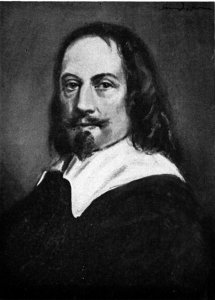19 October: Boreham on Thomas Browne
 A Doctor of the Old School
A Doctor of the Old SchoolOn this, the day after St. Luke's Day—the festival of all physicians—it is appropriate to celebrate the anniversary of the birth and of the death of one of the most attractive figures in our British story. Sir Thomas Browne was born on October 19, 1605, and he died on October 19, 1682.
When, in 1728, Samuel Johnson was entered at Pembroke College, Oxford, he expressed inordinate pride that, a hundred years earlier, Thomas Browne had passed through the some classical portal. The future lexicographer was thrilled by the thought that he was following in the exact footprints of the eminent 17th century physician. Men like Coleridge, Carlyle, Hazlitt, Lowell, and John Stuart Mill have became lyrical in praise of Sir Thomas Browne; whilst, in our own time, Dr. C. H Herford and Sir Edmund Gosse have written of him as one of the greatest of the great.
It has to be confessed that, in some respects, Sir Thomas Browne stands in our history as a distinctly spectral and shadowy figure. We have no authentic portrait of him. Eager to repair this deficiency, a 19th century antiquary outraged the honoured tomb of Sir Thomas in the historic old church of St. Peter Mancroft at Norwich, and stole the skull.
For many years the grim relic was on exhibition at the Hospital Museum at Norwich; but since—even if the right skull had been disinterred—it conveyed to very few people any life-like or convincing impression of its former owner, it was removed from the glass case in which it had been scrutinised by the morbid and the curious, and reverently restored to its original resting place.
A Citizen Of Far Off Ages
Our ignorance concerning the physique of the man, and our poverty as to the details of his career, are misfortunes for which Izaak Walton is very largely to blame. In the sixties, Izaak Walton took it into his wise old head to write the biographies of some of the most admirable characters of his time.
His choice little monographs of John Donne, Henry Wotton, Richard Hooker, George Herbert, and Robert Sanderson are still being published, and will live as long as the language endures; but, although he held Sir Thomas Browne in the highest esteem, his strength was exhausted before he was able to include the excellent doctor in the series. The two men—Walton and Browne—died about the same time. Walton's Life of Browne would have been a treasure worth possessing.
Like Walton, Sir Thomas Browne was a miracle of detachment. His greatest work, "Religio Medici," was published when the civil war was in full blast. Born in the spacious days of great Elizabeth, he saw the rise of the Stuarts, the outbreak of the rebellion, the ascendancy of the Puritans, and the execution of the King. He lived all through the days of the Commonwealth and he witnessed the Restoration. Yet, though England was a cloud of dust, not a speck nor a smut was permitted to settle on his pages.
He heard the rumble of distant thunder but never for a moment caught the spirit of the storm. He felt that he belonged, not to the noisy and quarrelsome age into which his body happened to have been cast, but to the ages of ancient thought in which there dwelt intellectual adventurers with whom his spirit was akin, and to unborn ages of science and discovery in which his mind seemed perfectly at home.
Link Between Two Intellectual Realms
The inner life of Sir Thomas Browne was dominated by two ideas. He was a doctor and he was a Christian. In the middle of the 17th century, this conjunction was regarded as an incomprehensible anomaly. How could a Christian be a doctor? How could a doctor be a Christian? Browne made it his business to show, not only that a doctor can be a Christian, and a Christian a doctor, but that the work of the physician may be consecrated by his faith and the creed of the Christian made intelligible by his healing ministry.
This is the argument of his masterpiece, "Religio Medici." It is embellished by a literary artistry that was peculiarly his own. In some respects he resembles Jeremy Taylor, whilst his more seraphic flights invite comparison with Milton himself. His philosophy is curiously tinctured with an infusion of fantasy. He had a mania for quincunxes—the arrangement of everything into sets of five. Coleridge used to say that Browne found quincunxes in the heavens above, quincunxes in the earth below, quincunxes in the mind of man, in the optic nerves, in the roots of trees, in feathers, leaves and everything.
But, whilst we smile at his occasional whimsies, we are bound to salute him as a very great man, a very great doctor, and a very great Christian. In his time, widely scattered towns and cities vied with each other in coaxing him to forsake his beloved Norwich and enrich their civic life with his personality and his skill.
When, a few years back, the British Medical Association met in Edinburgh, and St. Giles' Cathedral was crowded with doctors, Dr Alexander Whyte took the opportunity of exalting the brave record of Sir Thomas Browne, and of urging all physicians, and especially all young physicians, to sit afresh at the great man's feet. His teaching and example will be held in reverence to the utmost bounds of time.
F W Boreham
Image: Thomas Browne


<< Home